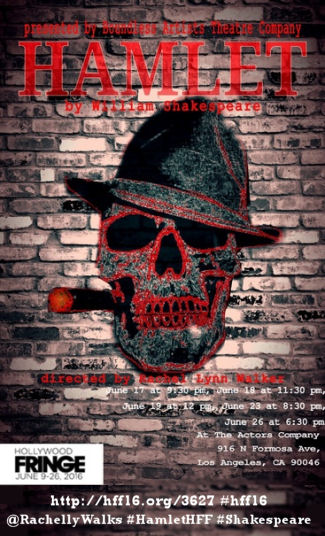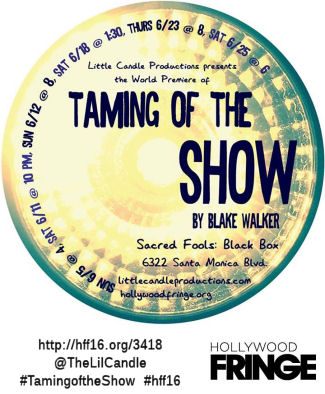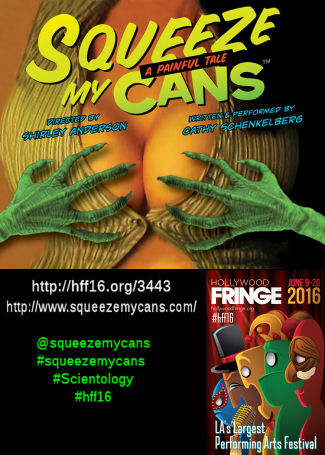
 When reading through the list of shows at the Hollywood Fringe Festival (FB), shows catch my eyes for various reasons. For example, yesterday’s show, Hamlet, was written up thusly:
When reading through the list of shows at the Hollywood Fringe Festival (FB), shows catch my eyes for various reasons. For example, yesterday’s show, Hamlet, was written up thusly:
Hamlet is set in the 1940s of Las Vegas and the Royal Family is the mob. Having a struggling desert town working its way towards greatness as a parallel for the turmoil that Denmark was going through connects modern audiences to a time they never experienced before. With a script cut to emphasize the story’s moral and original language to emphasize the depth of the story, this retelling of a classic will wow audiences.
Reading this, I thought: “Wow! Ever since I saw the Four Clowns presents Hamlet, I’ve been wanting to see another take on Hamlet. Plus, I’m a student of the history of Las Vegas (especially the mob era in Vegas), and this blend sounds fascinating. I’m in”. So we booked our tickets, and last night we worked our way to West Hollywood for our last show of the Fringe Festival: Hamlet, from the Boundless Artists Theatre Company/FB.
Alas, the description was better than the execution. This is not to say that the performance was bad — it wasn’t (although it had some problems). Rather, it simply didn’t match the expectation created from the catalog description. Let’s analyze why, and what could have been done to fix it.
Let’s start with that first line: “Hamlet is set in the 1940s of Las Vegas and the Royal Family is the mob.” Great, great idea. So we walk into the theatre, and it is a black box with no set, no projections. The only intimation that we are dealing with the mob is that everyone is in black suits and dark shirts and carry guns, and the ladies are in heels with black hose. Yup. Damon Runyon (think “Guys and Dolls”) mobsters. That’s it. The language still refers to Kings and Queens and Princes and Denmark and France, but with a light New York accent. That’s all that gives us the sense of place. Doesn’t work. Nothing in this execution said “Vegas” at all.
So, what could they have done? First, move it up about 8-10 years. In the early 40s, the only resorts on the strip were El Rancho Vegas and The Last Frontier, both started before the war and both without heavy mob involvement. The Flamingo opened in 1946, and the era that is desired is the 10 year era after that, probably best between 1954 and 1956 when you had a number of mob-owned “union pension fund funded” resorts opening. 1954 is particularly good: you’ve got the El Rancho, Last Frontier, Flamingo, Sahara, Sands, Desert Inn, and Thunderbird operating. Go to 1958 and you can add about 5 more, including the Stardust and Riviera. Make Claude (Claudius) the general manager of the hotel, who bumped off the previous general manager and married his wife, Gertrude. Hamlet could remain Gertrude’s son, and perhaps be something like the Casino Director who doesn’t like the situation, perhaps because Claude was the general manager at a competing resort (and, yes, this happened at the time — look up folks like Gus Greenbaum, who was brought in to manage the Riviera in 1955, after successfully managing the Flamingo Hotel after the death (some would say mob hit) of Bugsy Siegel. In December 1958, Greenbaum and his wife were murdered in their Phoenix, Arizona home, reportedly on the orders of either Meyer Lansky or Tony Accardo. Make the other characters have similar changes: Ophelia as Hamlet’s girlfriend who works in the hotel; Laertes in another position and connected to his father, Polonius, who perhaps works with one of the union pension funds. The key point is that if you are going to set it in Vegas and the mob-controlled strip, you have to adjust the story to that context and mileau. Tweak the characters and names. As this is Fringe, use projections to establish the places: the hotel, offices, on the casino floor, in the desert burying a body. Make the costumes era appropriate and not caricatures of what you think the era is.
The mob Vegas aspect is a wonderful place to set the Hamlet story and to modernize it (doing so could be a great start at a fun screenplay). However, the execution of this version just failed miserably on that count. It was less visible than the Royal Nevada. The director, Rachel Lynn Walker (FB), who was also responsible for the adaptation and adjustments, needed to study and understand the era before attempting to do this.
Independent of screwing up the theme, how was this production as Hamlet itself? What would Billy Shakespeare think? By the way, if you aren’t familiar with Hamlet, either read the Wikipedia entry, the sparknotes, or the play itself.
On this aspect, the show was a bit better, but was still flawed (but see the note at the end). The adaptation did a lot of work to preserve the key lines that everyone expects from Hamlet. That was the good part. The bad part was that many of the actors spoke their lines far too fast, and without clear enunciation, which made it difficult for the audience to follow the story (which is already difficult given the unfamiliarity with Shakespeare’s language and language patterns). This was evidence from the moment when Bernardo steps on the stage and speaks his first lines (the actor playing Bernardo was one of the worst — but far from the only — offender). This problem I blame squarely on the director, Rachel Lynn Walker (FB), who has the responsibility to guide her actors to ensure they can be heard and understood by the audience. I have to tell technical students this all the time: slow down and speak clearly. This is certainly true for actors, who must add projection on top of that (and is doubly true when you are adding an accent).
So, we set aside the theme, and we set aside hearing many of the actors, and what do we have left? The performances. I’m pleased here to say there were some strong performances that offset the weak and worked to carry the story. We’ll do it in the usual tiers, with highlights.
At the time, of course, there is Evan Garcia (FB)’s Hamlet. For the most part, Garcia spoke clear but perhaps a little fast, and captured the emotions well (although he might need to a bit of work to convey the madness of Hamlet a little better). He also didn’t appear to have the strong connection required with Cynthia Asmar/FB‘s Ophelia, who is supposedly his love. Asmar’s Ophelia was fun to watch — kudos for casting diverse body shapes — and handled most of her lines well.
As the King and Queen, Richard Lozoya (FB) and Lauren Sanatra (FB), respectively, performed reasonably well. My wife thought Lozoya spoke a little fast; I thought he was OK. More importantly, other than the words there was nothing to convey a good sense of what the relationship was between Hamlet and these folks, and why he cared about them at all.
Polonius was played by Sergio Venegas (FB), and he had one of the best performances of the team. He spoke clear and loud, and did a great job of conveying his meaning. Shannon Walker (FB)’s Horatio worked well sometimes and at other times spoke too fast. In any case, she performed well and was fun to watch. However, there were a few points where it was clear she was struggling on the next line; by the 5th Fringe show that problem should have gone away. Her partner-in-crime, Daniel Verdugo/FB‘s Bernardo, was more of a problem. He always spoke too fast and too softly, and it was often difficult to figure out what he was saying or doing.
Rounding out the cast were Andrew Cercedes (FB) as Guildenstern, Joy Ann-Marie Horn/FB as Rosencranz, and Ryan Jones/FB as the ghost. Rosencranz and Guildenstern needed to work on their projection and slow down a bit more.
Turning to the production side again, there was no credit provided for set design, because there was no set. Costume and Prop design was by the director, Rachel Lynn Walker (FB), and here again there were some distracting fails. My wife noted that the shoes were wrong for the era. At one point Joy Ann-Marie Horn/FB was an a dress with a large opening in the back, and a bra strap was clearly visible. This did not fit the era in question — either the 1940s or 1950s. In the final scenes, Shannon Walker (FB) needs to watch out as she was about falling out of her top when she was leaning forward. Again — that’s a costuming problem that should have been caught by the director. Actors seemingly kept dropping their props, and the variety of guns was off. On the plus side, the fight and dance choreography by Richard Lozoya (FB) was quite good. No credit was provided for stage management or lighting design. Justin Huen operated the board, and the production was presented by the Boundless Artists Theatre Company/FB.
Note: Writing this up uncovered the fact that most of the actors, as well as the director, of this production are relatively new to the industry. I do not want this writeup to seem harsher than it should — they were very good for their skill level. The problem is: the audience (especially an audience at Fringe) doesn’t know the actor’s skill level. As a result, the actors and production team need to up their game. There are things one overlooks because it is Fringe: fancy sets, fancy costumes, lots of rehearsal time in the space. But other things are space independent: learning to speak at a speed where the audience can understand, speaking with sufficient projection and enunciation to convey the story. Exhibiting emotions and relating is one thing, but what makes something a play over a pantomime is the writing. I encourage these young actors to keep practicing and working at the craft, and hope to see them much improved next year. This is where a skilled director can come in; they can educate and teach while molding and shaping. I fear the director in this case was overextended: not enough time to research for the writing, not enough time to rehearse with the actors, and not enough time to research to get the costumes to convey the message. In any case, this company still has a skill I don’t have — inhabiting another character. I’m just an engineer who knows how to write.
We saw the last performance of Hamlet, and it looks like it wasn’t extended for the Fringe Encore Awards.
Attention Programmers! Take the Fringe Programming Challenge! Scheduling your shows at the Fringe can be a pain in the …. I’m trying to solve the problem for next year, so take a look at my specs for a Fringe scheduling app. Can you write it?
* * *
Ob. Disclaimer: I am not a trained theatre critic; I am, however, a regular theatre audience member. I’ve been attending live theatre and concerts in Los Angeles since 1972; I’ve been writing up my thoughts on theatre (and the shows I see) since 2004. I do not have theatre training (I’m a computer security specialist), but have learned a lot about theatre over my many years of attending theatre and talking to talented professionals. I pay for all my tickets unless otherwise noted. I am not compensated by anyone for doing these writeups in any way, shape, or form. I currently subscribe at Cabrillo Music Theatre (FB) and the Hollywood Pantages (FB); my subscription at The Colony Theatre (FB) has gone dormant, and REP East (FB) has seemingly gone dark for 2016. Through my theatre attendance I have made friends with cast, crew, and producers, but I do strive to not let those relationships color my writing (with one exception: when writing up children’s production, I focus on the positive — one gains nothing except bad karma by raking a child over the coals). I believe in telling you about the shows I see to help you form your opinion; it is up to you to determine the weight you give my writeups.
Upcoming Shows: Ah, June. Wonderful June. June is the Hollywood Fringe Festival (FB), and I’ve already written about the shows I plan to see, as well as suggestions to the Fringe regarding viewing the audience as a customer. Our Fringe/June schedule is as follows (for shows in the past, ✍ indicates writeup is in progress; ✒ indicates writeup is complete and links to the writeup):
Whew. July brings us back to conventional theatre, with Beautiful at the Hollywood Pantages (FB) and the Western Corps Connection (FB) the first weekend, Grey Gardens at the Ahmanson Theatre (FB); the second weekend, The Little Mermaid at Cabrillo Music Theatre (FB); the third weekend, Weird Al Yankovic at the Hollywood Bowl (FB) and Operaworks (FB) Opera Re-Constructed at CSUN; the fourth weekend, a mid-week Hollywood Bowl (FB) concert of Wynton Marsalis and Aaron Copeland, and … currently nothing for the weekend. As of right now, August is completely open. One weekend has a bar mitzvah, and there are a few holds for show, but nothing is booked. Late August may see us looking at shows down San Diego/Escondido for one weekend. The best of the shows available — or at least the most interesting — is Titanic from Moonlight Stages. September is similarly mostly hold dates at this point. As always, I’m keeping my eyes open for interesting productions mentioned on sites such as Bitter-Lemons, and Musicals in LA, as well as productions I see on Goldstar, LA Stage Tix, Plays411 or that are sent to me by publicists or the venues themselves.
 The Hollywood Fringe Festival (FB) schedule is starting to gel. I’ve done some further planning over lunch, and here is how June stands. We are ticketing in two groups: this weekend (¹), and right after June 1st (²), to split the charges.
The Hollywood Fringe Festival (FB) schedule is starting to gel. I’ve done some further planning over lunch, and here is how June stands. We are ticketing in two groups: this weekend (¹), and right after June 1st (²), to split the charges.


 This was a Fringe production, and in their program they note that they “hope to use this opportunity at the Hollywood Fringe Festival to expand our audiences and develop the piece further”. I spent some time this morning, as I researched and wrote this, thinking about that question. The question that keeps coming to mind is: Is the Anne we meet when the play opens the same Anne as at the end of the play, and how do we make that clear. The Anne of the original book resonated with people because of the combination of youthful naiveté, wisdom, and optimism. Did these few days shape that, or did they create or change something about Anne? Figuring out the way to address dramatic visualization of that transformation would appear to be the “development” that would be appropriate. The other characters in the piece are the catalysts for Anne’s growth — and like catalysts, enable the reaction while staying unchanged or minimally changed.
This was a Fringe production, and in their program they note that they “hope to use this opportunity at the Hollywood Fringe Festival to expand our audiences and develop the piece further”. I spent some time this morning, as I researched and wrote this, thinking about that question. The question that keeps coming to mind is: Is the Anne we meet when the play opens the same Anne as at the end of the play, and how do we make that clear. The Anne of the original book resonated with people because of the combination of youthful naiveté, wisdom, and optimism. Did these few days shape that, or did they create or change something about Anne? Figuring out the way to address dramatic visualization of that transformation would appear to be the “development” that would be appropriate. The other characters in the piece are the catalysts for Anne’s growth — and like catalysts, enable the reaction while staying unchanged or minimally changed.



